Using Game Based Training to Socialise Your Dog – Tuffies Wooly Pet Bedding
Once when Gerry was 6 months old I took him for a walk down to the river. I usually decided that that was a good place to go because there were often other dogs there that he could practice socialising with. Sure enough the scent of a dog coming the other way entered Gerry’s nostrils but this time his reaction was a bit disconcerting, he flattened out like an alligator in anticipation. This had happened one or twice before and I knew that the situation might go south quite quickly, especially if the other dog was a young male. I was prepared with the highest value rewards I could think of, chicken and cheese. If I could get him to concentrate on the food it would snap him out of his confrontational mindset and also get him to associate other dogs with tasty rewards and a positive experience. Other dogs are also much less likely to react if they’re being ignored.
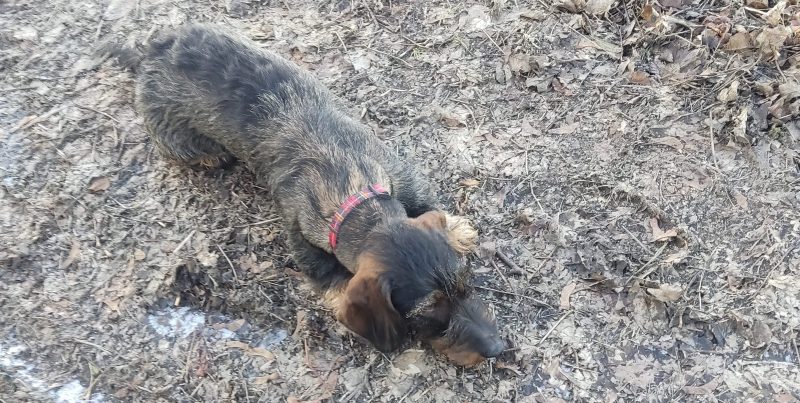
Gerry Flattening Out After Noticing Another Dog
Anyway, it didn’t work. The luxurious chicken breast and Cathedral cheese was of absolutely zero interest to Gerry, whose eyes remained firmly locked onto the approaching ‘threat’. The other dog had seemed fairly calm as it approached but reacted with aggression to Gerry’s stand-offish attitude and in the blink of an eye they were at it, snapping as if they’d been mortal enemies their entire lives. I didn’t really blame Gerry for being defensive in the face of a much larger dog, but I also knew that if his attention had been on me, it probably wouldn’t have turned ugly. It usually takes two to tango and even aggressive dogs will often just have a sniff and move on if they’re being ignored.
I was conscious of the fact that every bad experience Gerry had with another dog would add to his anxiety around them and make the problem worse going forwards, so I decided something needed to change. Socialising is important though and I definitely didn’t want to shield him from every other dog for the rest of his life. Not only would that be a hassle for me, it would be depriving him of his own kind and wouldn’t really be addressing the problem, just avoiding it. It would also mean I’d have to keep him on the lead around dogs he didn’t already know, and what kind of life is that? Normally cheese/chicken worked, at least indoors it did. But now that he was growing up, producing testosterone and becoming curious about rabbits, crows and other distractions it clearly wasn’t enough. I needed something else, a more enticing reward for the behaviour I was trying to encourage.
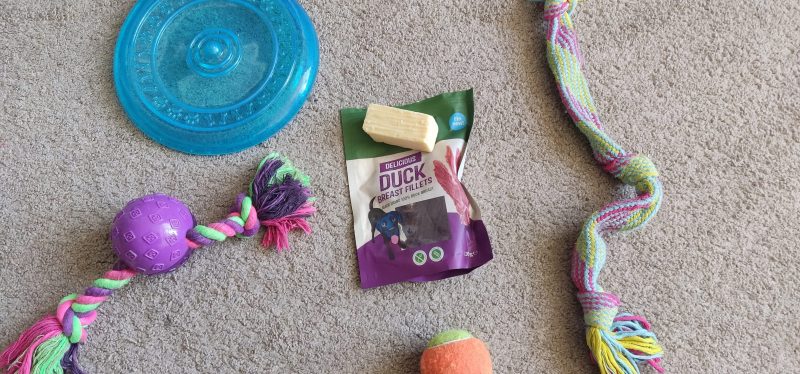
Gerry’s Rewards – Trying to Select a Favourite
I started testing each of his toys to see which game was his favourite and then hopefully use it to grab his attention around other dogs. Gerry liked playing tug, he also thought tennis balls were ok but neither of them would cut the mustard when it really mattered. He’d recently found a rubber ball on one of his walks, which he seemed to value a bit more than the rest of his toys. For some reason he preferred the texture to fuzzy tennis balls. I found the same one online but this one had a brand-new squeaker inside. It completely fixated him, now we’re talking.
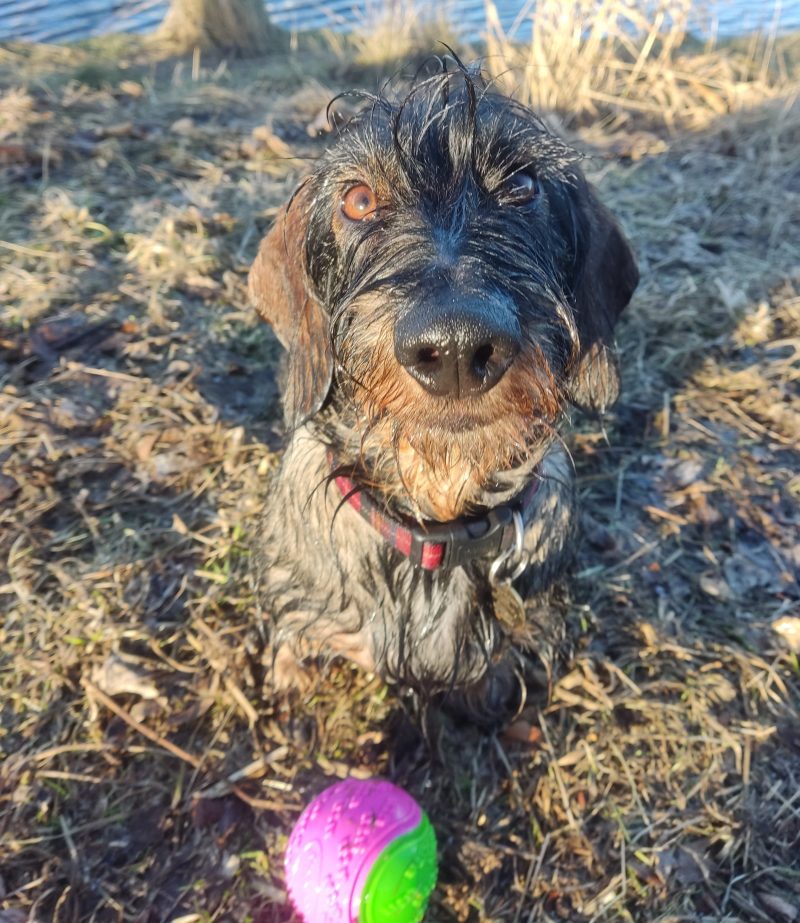
Gerry with his Favourite Squeaky Ball
The mistake at this point would have been to let him have that ball whenever we were playing/training him. Instead, we rationed it and only used it around the most difficult of distractions. For Gerry, those were other dogs and wildlife. The problem with a ball is that it’s not much fun when you’re on a lead because fetch doesn’t really work so I avoided other dogs whilst he was on lead. The first time we encountered another dog off-lead I was ready with the holy grail, the squeaky rubber ball. It was hilarious to watch the cogs turning in his brain, he’d hit the deck in anticipation of the threat again a few days later and his nose was downloading the data but at the same time his eyes were fixed on me and my rubber ball. I said “watch” (even though he was already looking at me), squeezed the ball and threw it in the opposite direction and he just could not resist tearing after immediately. He didn’t retrieve it but that didn’t matter, his attention was off the other dog and his body language was entirely different. Ears and hackles down, tail wagging, nervousness gone. By the time the other dog had approached him, Gerry was way too preoccupied with his favourite toy to care. It wasn’t often he got the opportunity to play with it and that drive was just enough to overpower his fixation on the dog.
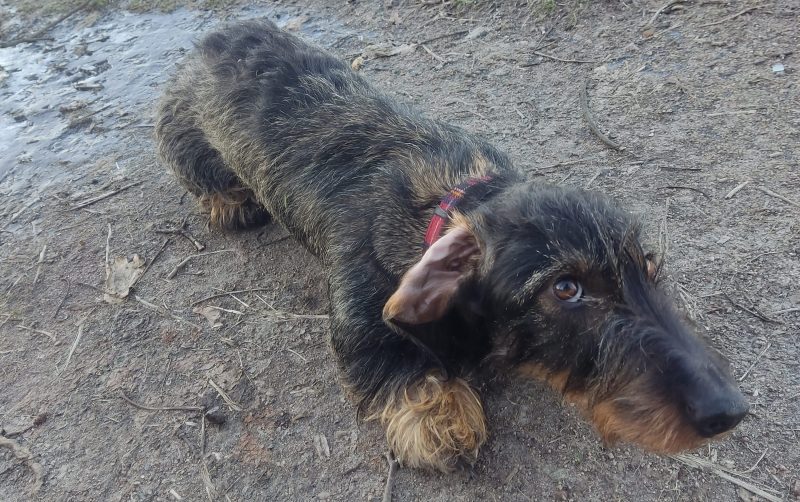
Gerry’s Attention Turning to THE Ball Even as Another Dog Approaches
Some dogs will do anything for food, no matter how distracted. Labradors are generally more food oriented and older dogs are also more likely to do what they’re told for a snack but with puppies it’s often the other way around. Dog owners go wrong by overusing valuable toys or allowing them access to those toys full time at home. Gerry hardly ever gets his favourite rubber squeaky ball and that’s part of the reason it’s so appealing to him. On walks I’ll have it in my pocket but I’ll only throw it for him a handful of times and I’ll save those occasions for when I really need his attention. Also, if he starts chasing a rabbit I won’t just throw the ball near him because I don’t want him to think that good things happen whilst chasing wild rabbits. I’ll call him back, ask for a sit or spin or paw, and then throw it. The command doesn’t matter, all that matters is that he gets a reward that matches the difficulty level of the thing that I’m asking of him. With socialising, toys are also often a better distraction than food because a game lasts longer than it takes for them to gobble a treat. On top of that, nervous dogs are so adrenaline filled in the face of another dog that appetite goes out the window and only a different type of adrenaline will be enough to snap them out of it. Chasing a toy is a much healthier type of adrenaline.
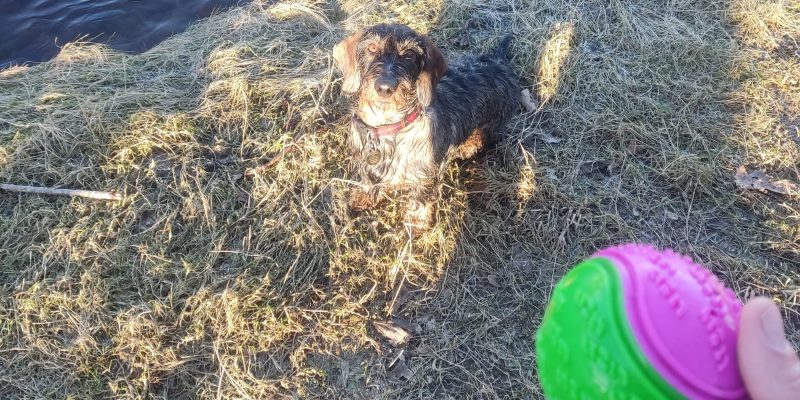
Gerry Fixated on the Rubber Ball
Lastly, make sure your game is FUN. With tug you have to put effort into making it exciting for them by pulling the toy around in different directions, like they’re doing to you, and let them win about 50% of the time. If fetch is their passion, throw the ball low to the ground so that it takes exciting jumps as it hits bumps along its route. Your dog wants to feel as if they’re chasing unpredictable prey. It will take a couple of weeks of limiting the toy before you’re ready for that difficult scenario, whatever it may be.
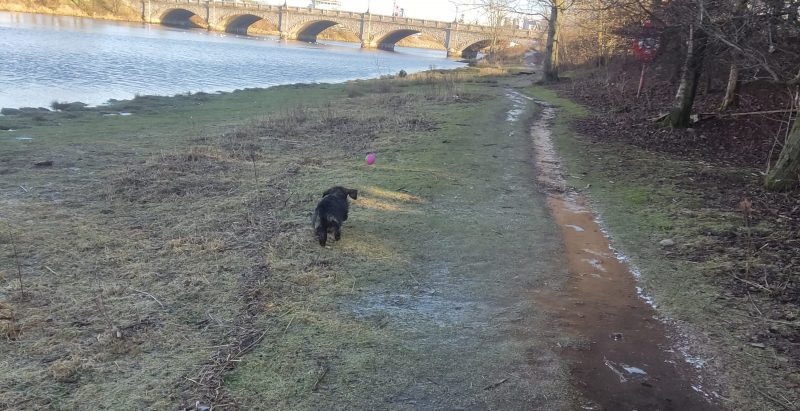
Gerry Chasing the Ball
Gerry now sees other dogs as a cue for access to his favourite toys. Even when they get up in his grill, his attention remains on me and his tail wags. Even if the other dog is looking for a scrap, they’ll read his body language as non-threatening and usually carry on with their day as normal. Good boys.
Cold Dog?
January is freezing and heating is expensive. It’s easy to forget that our pets don’t have the privilege of putting another jumper on when they’re cold. Therefore it’s important to give them places they can go to heat up. Cue sales pitch! The Tuffies Nest Sock does just that, with its fleece material it creates a den that your dog can burrow into and create some heat. We also have an array of covers to add or remove from your Tuffie depending on the season such as the Tunnel Mattress Dog Bed Cover, Luxury Fleece Dog Bed Cover, Fluffie Tuffie Dog Bed Cover. If your dog get access to the sofa, chuck some Wooly Pet Bedding over it to protect your cushions and blankets from that dog smell.
-
30/12/2022 13:48
How to Fix Your Dogs Fear of Fireworks with a Bluetooth Speaker, a Tuffies Nest and Loads of Tasty Treats
Recently I’ve heard some horror stories about dogs taking off in a state of panic in reaction to fireworks. I’ve also seen lots of social media posts demanding they be banned and you can understand the passion of som.. -
21/02/2023 12:57
Building Puppy Confidence - Tuffies Waterproof Dog Beds
Some breeds of dogs are more susceptible to anxiousness than others. Stress is at the heart of many common problems including barking, chewing, aggression, and separation anxiety. Here's how to develop confidence in your..



